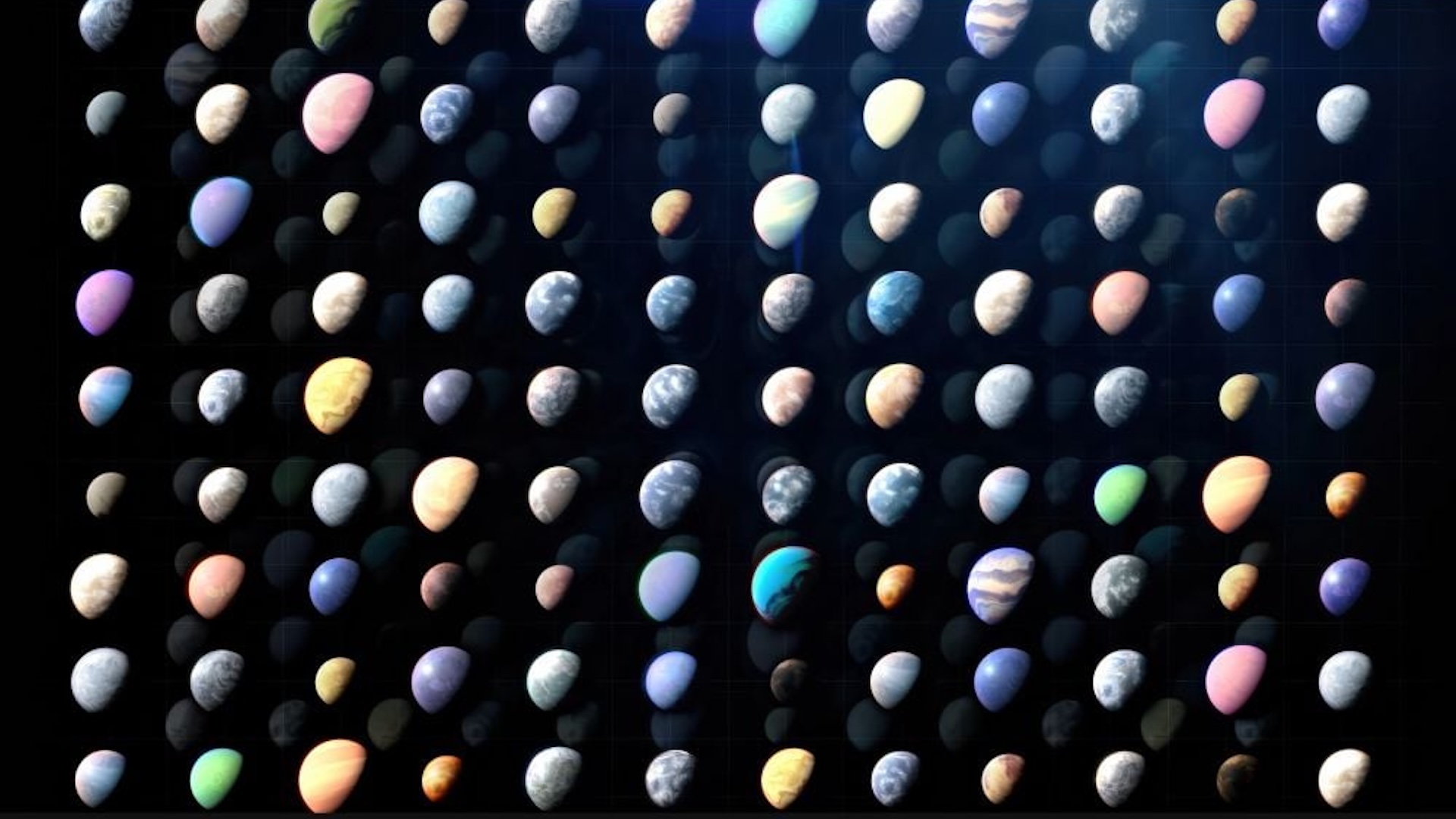Copyright livescience

Skip to main content Close main menu Live Science Sign up to our newsletter View Profile Search Live Science Planet Earth Archaeology Physics & Math Human Behavior Science news Life's Little Mysteries Science quizzes Newsletters Story archive Man regains vision by tooth to eye implant 5,000-year-old stone tomb in Spain Abandoning daylight saving time JWST discovers possible black hole star Million-year-old skull from China rewrites human origins Don't miss these How many moons are in the solar system? Bad news for alien life? Earth-size planets may be less common than we thought 5th planet found orbiting nearby star may lie in habitable zone What are dwarf planets — and how many are there? Scientists detect gargantuan 'pimple' that has plagued a star for at least 7 years 'The most significant JWST finding to date': James Webb spots — then loses — a giant planet orbiting in the habitable zone of our closest sun-like star Stunning 'sun dogs' could sparkle in alien skies, James Webb Space Telescope suggests The hunt for 'Planet Nine': Why there could still be something massive at the edge of the solar system Astronomers spot alien planet system being born before their eyes Astronomers witness a newborn planet emerging from the dust around a sun-like star: Space photo of the week 3I/ATLAS: Everything you need to know about the new 'interstellar visitor' shooting through the solar system Astronomers discover monster exoplanet hiding in 'stellar fog' around young star TRAPPIST-1e might have an atmosphere, JWST hints The Rubin Observatory found 2,104 asteroids in just a few days. It could soon find millions more Astronomers discover origins of mysterious double hot Jupiter exoplanets: 'It is a dance of sorts' It's official: Humans have found 6,000 planets beyond our solar system Evan Gough 27 September 2025 Just two decades after astronomers discovered the first exoplanet, NASA has confirmed the existence of 6,000 alien worlds. The total will rise even quicker as next-generation telescopes take flight. When you purchase through links on our site, we may earn an affiliate commission. Here’s how it works. Exoplanet science has reached another milestone. NASA has announced that there are now 6,000 confirmed exoplanets. They vary widely in type and size, and in what types of stars they orbit. (Image credit: NASA’s Goddard Space Flight Center) The age of exoplanets began in 1992, when astronomers detected a pair of planets orbiting a pulsar. Then, in 1995, astronomers discovered the first exoplanet orbiting a main sequence star. As NASA's Kepler and TESS missions got going, the number of confirmed exoplanets continued to rise. By 2015, NASA announced that Kepler had discovered its 1000th exoplanet. 2016 was a banner year for exoplanet detections with nearly 1500 in that year alone. The total number reached 5000 in March of 2022. Now, NASA has announced that there are 6,000 confirmed exoplanets. 6,000 is a lot, though compared to the one hundred billion that may exist in the Milky Way, it's a tiny amount. Still, for a fledgling space-faring civilization like ours, it's something to celebrate. You may like How many moons are in the solar system? Bad news for alien life? Earth-size planets may be less common than we thought 5th planet found orbiting nearby star may lie in habitable zone The fact that we've found 6,000 is impressive, considering how challenging they are to detect. There are vast distances between us and other stars. Many exoplanets will be hidden in the glare from their stars, or they're so far from their stars that they're practically undetectable. With history as a guide, it's clear that technological advances will bring more of them within reach, barring the collapse of civilization or the abandonment of science. Exoplanet science is, obviously, about more than sheer numbers. The variety of planets we've discovered teaches us vital things about nature, our own Solar System, and about the precious Earth. Curiously, many of the planets we've discovered are unlike anything in our own Solar System. There are hot Jupiters, massive gas giants that orbit their stars in a matter of days. There are ultra-short period planets that put Mercury's short orbital period to shame by completing orbits in mere hours. One strange type of planet are so close to their stars that they're tidally locked to their star like the Moon is to Earth. These planets have one scorching hot side and one frigid side. Some of them may be hot enough to remain molten. Others have such extreme temperatures, pressures, and chemical constituents that they may rain iron, or may be no denser than styrofoam. Some could be covered in oceans. Others swathed in toxic gases. Sign up for the Live Science daily newsletter now Get the world’s most fascinating discoveries delivered straight to your inbox. Contact me with news and offers from other Future brandsReceive email from us on behalf of our trusted partners or sponsorsBy submitting your information you agree to the Terms & Conditions and Privacy Policy and are aged 16 or over. This is an artist's illustration of WASP-76b. Initial observations suggested that it may rain iron. Subsequent observations suggested that's not the case. Still, the idea that an exoplanet out there somewhere could rain iron is compelling. (Image credit: International Gemini Observatory/NOIRLab/NSF/AURA/J. da Silva/Spaceengine/M. Zamani, CC BY 4.0, via Wikimedia Commons) Somehow they're all part of nature. Determining how they came to be is an enduring fascination. But at the base of all of this searching and wondering is the one big question: Are we alone? "Each of the different types of planets we discover gives us information about the conditions under which planets can form and, ultimately, how common planets like Earth might be, and where we should be looking for them," said Dawn Gelino, head of NASA's Exoplanet Exploration Program (ExEP) at the agency's Jet Propulsion Laboratory in Southern California. "If we want to find out if we're alone in the universe, all of this knowledge is essential." You may like How many moons are in the solar system? Bad news for alien life? Earth-size planets may be less common than we thought 5th planet found orbiting nearby star may lie in habitable zone The vast majority of exoplanet detections are indirect. The transit method detects planets by measuring how much light an exoplanet blocks when it passes in front of its star. The radial velocity method detects the slight tugs exoplanets give to their stars and measure how the star's light changes by wobbling. Astrometry detects miniscule movements, and in gravitational lensing, the presence of a planet introduces anomalies into the observed light. Both Kepler and TESS used the transit method, and that method is responsible for most exoplanet detections with almost 4500. Radial velocity is next with about 1140 detections. Though effective, they're indirect. Only direct imaging can measure the chemistry of exoplanet atmospheres and doesn't require particular orbital alignments or orientations. But it's difficult, and fewer than 100 exoplanets have been directly imaged. This is the HR 8799 system with its four exoplanets. The exoplanets and their orbits were confirmed with direct imaging, making them some of the few exoplanets to be directly imaged. (Image credit: NASA, ESA, CSA, STScI, Laurent Pueyo (STScI), William Balmer (JHU), Marshall Perrin (STScI) - HR 8799 (NIRCam Image)) 6,000 confirmed exoplanets is a definite, concrete scientific milestone. But there are thousands of other candidates, and it takes a lot of work to confirm a candidate. Something else could be creating the signal, like stellar flaring or artifacts with the transit method. Follow up observations, sometimes with a different telescope, confirms them, and that takes a lot of time and observing resources. As of July 2025, TESS had a list of 7655 exoplanet candidates of which just over 600 have been confirmed. "We really need the whole community working together if we want to maximize our investments in these missions that are churning out exoplanets candidates," said Aurora Kesseli, the deputy science lead for the NASA Exoplanet Archive at IPAC. "A big part of what we do at NExScI is build tools that help the community go out and turn candidate planets into confirmed planets." We could be facing a glut of exoplanet discoveries that was unimaginable a couple of decades ago. Candidate exoplanets are still being found in Gaia data, even though that mission ended. NASA's Nancy Grace Roman Space Telescope, which should launch in 2027 unless the current administration's threats to cancel it come true, should discover thousands more through microlensing. An artist's illustration of NASA's Nancy Grace Roman Space Telescope. It's poised to discover thousands of exoplanets with its microlensing survey. (Image credit: NASA) The age of exoplanets is beginning to shift, though. Our searches are becoming more targeted. Rather than casting a wide net and seeing what they catch, astronomers are seeking to find more specific types of exoplanets. ESA's PLATO is poised to detect many more rocky exoplanets around Sun-like stars after its launched in 2026. The Habitable Worlds Observatory is just a proposal at this point, but it will search for habitable exoplanets in habitable zones and will also contribute to the ballooning list of exoplanets. Other missions, like CHEOPS and ARIEL will study known exoplanets in greater detail. This infographic features artist's illustrations of current and future telescopes involved in exoplanet science. Some are designed to cast a wide net and catch as many different exoplanets as possible. Others are target at specific types of exoplanets. Others are built to study known exoplanets and to better characterize them. (Image credit: NASA/JPL-Caltech) The holy grail in exoplanet science is habitability. A lot goes into determining habitability, with only a few exoplanets displaying any possibility of being habitable. The key is finding biosignatures, particular chemicals that tell us life is active on a planet. The JWST with its infrared atmospheric spectrometry, is just beginning to address this and has already produced some tantalizing results, though nothing concrete yet. Like all scientific endeavours, the search for exoplanets has been boosted by technological advances, and that will continue in the future. One of the big obstacles in exoplanet science concerns that stars that planets orbit. Stars are extraordinarily bright and the presence of a comparatively dim exoplanet can be entirely obfuscated by starlight. This is especially true in focused searchers for Earth-like worlds around Sun-like stars like the Habitable Worlds Observatory (HWO) is conceived to detect. The HWO will need a powerful coronagraph or starshade to do its job. If a distant astronomer were searching for Earth around the Sun, they would have a tough time detecting it in all that starlight. That's effectively what astronomers will be doing with the HWO. RELATED STORIES —32 alien planets that really exist —JWST finds planet with all-carbon atmosphere orbiting 'black widow' star —Ginormous planet discovered around tiny red star challenges our understanding of solar systems China is beginning to leverage its technological prowess in the exoplanet sphere, too. Its Earth 2.0 (ET) Space Telescope is set for launch in 2028 and will spend four years searching for exoplanet transits. It's China's first dedicated exoplanet-hunting mission and is focused on Earth-sized exoplanets. Eventually, we will have a list of confirmed Earth-like exoplanets around Sun-like stars. Then we'll face an even more challenging task: figuring out if any of those worlds actually host life. The original version of this article was published on Universe Today. Writer, Universe Today Evan Gough is a science communicator who organizes and produce content that helps readers discover the fascinating planet, solar system, galaxy and universe we inhabit. He cover everything from the scientific triumphs of Mars rovers, to getting humans back to the Moon, to the mysterious nature of black holes. You must confirm your public display name before commenting Please logout and then login again, you will then be prompted to enter your display name. How many moons are in the solar system? Bad news for alien life? Earth-size planets may be less common than we thought 5th planet found orbiting nearby star may lie in habitable zone What are dwarf planets — and how many are there? Scientists detect gargantuan 'pimple' that has plagued a star for at least 7 years 'The most significant JWST finding to date': James Webb spots — then loses — a giant planet orbiting in the habitable zone of our closest sun-like star Latest in Exoplanets JWST finds planet with all-carbon atmosphere orbiting 'black widow' star A real-life Pandora? Newfound 'disappearing' planet in our neighboring star system could have a habitable moon, just like the Avatar movies Stunning 'sun dogs' could sparkle in alien skies, James Webb Space Telescope suggests 5th planet found orbiting nearby star may lie in habitable zone A doomed exoplanet is caught in a 'death spiral' around its star. Can it survive? Bad news for alien life? Earth-size planets may be less common than we thought Latest in News Is acetaminophen safe in pregnancy? Here's what the science says. Mysterious cosmic explosion can't be explained, scientists say Amazon rainforest trees are resisting climate change by getting fatter from CO2 in the atmosphere Scientists unveil world's first quantum computer built with regular silicon chips 'If there is a space race, China's already winning it': NASA unlikely to bring Mars samples back to Earth before China does, experts say 'Gold coins started appearing one after another': 1,400-year-old hoard with money and jewelry unearthed near Sea of Galilee LATEST ARTICLES Why does medicine taste bad? Is acetaminophen safe in pregnancy? Here's what the science says. Mysterious cosmic explosion can't be explained, scientists say Our reviewer's 'go-to' sports watch has just dropped to its lowest-ever price Scientists are unraveling the link between pollution and psoriasis Live Science is part of Future US Inc, an international media group and leading digital publisher. Visit our corporate site. Contact Future's experts Terms and conditions Privacy policy Cookies policy Accessibility Statement Advertise with us Web notifications Editorial standards How to pitch a story to us Future US, Inc. Full 7th Floor, 130 West 42nd Street, Please login or signup to comment Please wait...



